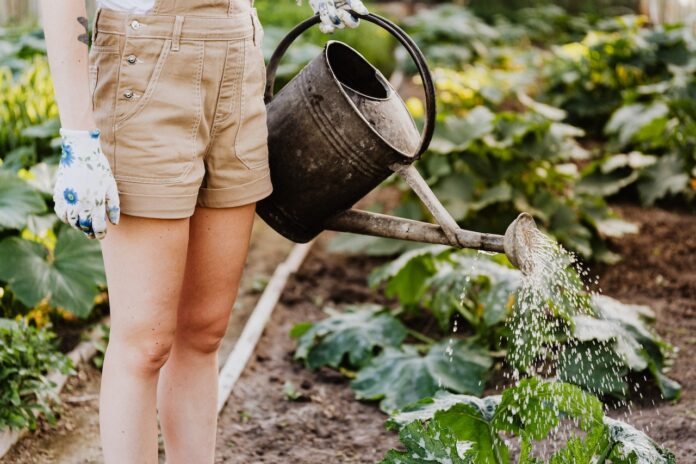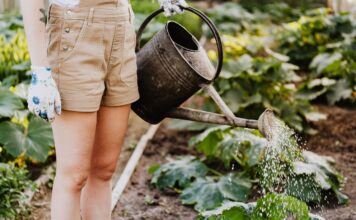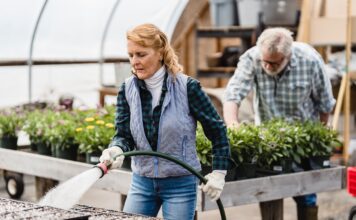Dive into the world of hydroponic gardening with this comprehensive guide, covering everything from understanding hydroponic gardening and its principles to setting up a system and managing your plants. Learn about the different types of hydroponic systems, their components, and the crucial aspects of water, lighting, temperature, and humidity. Explore the various grow mediums, nutrient solutions, and lighting options, as well as the benefits and challenges of hydroponic gardening. Discover how to choose the right plants, ensure their health, and maximize yield, all while gaining insights on harvesting techniques and post-harvest handling. Whether you’re interested in DIY or commercial solutions, this article is your go-to resource for all things hydroponics.
Understanding Hydroponic Gardening
Definition and Overview
Hydroponic gardening is a method of growing plants without soil, using mineral nutrient solutions in a water solvent to provide necessary nutrients directly to the plants’ roots. In hydroponic systems, plants are typically grown in an inert growing medium, such as coconut coir, perlite, or rockwool, to give the plants structural support and anchor the roots in place. The growing medium does not supply nutrients like traditional soil; instead, it merely serves as a placeholder for the roots, making it possible for both nutrient uptake and proper aeration to happen.
This alternative method to traditional soil-based gardening is gaining traction among hobbyists, commercial growers, and researchers who appreciate the increased control over nutrient levels, water use, and environmental conditions that hydroponics offers. Hydroponic gardening can be done indoors or outdoors and can range in scale from small home-based systems to enormous commercial operations.
History and Evolution
The concept of hydroponics dates back thousands of years, with ancient civilizations such as the Babylonians, the Aztecs, and the Chinese using rudimentary forms of soilless plant cultivation.
The modern-day development of hydroponics began in the 17th century when British scientist Sir Francis Bacon published a series of works on water culture. However, it was not until the 1930s that Dr. William Frederick Gericke of the University of California, Berkeley, coined the term “hydroponics” to describe his soil-free plant growth experiments.
Over the next few decades, various researchers improved and refined hydroponic methods to increase efficiency, reduce costs, and expand the range of plants that could be grown using this method. The popularization of hydroponics is sometimes attributed to its use in NASA’s Controlled Ecological Life Support System (CELSS) in the 1970s, which proposed the cultivation of plants to sustain astronauts on long space missions.
Since then, hydroponic technology has continued to evolve, and its adoption has expanded across the globe for various applications, from urban gardening to large-scale commercial agriculture.
Basic Principles
The success of hydroponic gardening depends on the careful management of several key factors, including: 1. Nutrient solution: The nutrient solution provides all essential nutrients directly to the plants’ roots. It is composed of macro- and micro-nutrients and must be balanced to ensure optimal plant growth. 2. Oxygenation: Adequate oxygen levels in the root zone are crucial for plant health, as roots need oxygen to respire and absorb nutrients. The introduction of air stones, diffusers, or circulation pumps can help increase oxygen levels in the nutrient solution. 3. pH levels: Maintaining the proper pH level, typically between 5.5 and 6.5, is essential for nutrient availability to the plants, as certain nutrients’ absorption rates are affected by the pH level. 4. Temperature and humidity: Controlling the temperature and humidity in the growing environment greatly impacts plant growth, and must be monitored and adjusted accordingly. 5. Light spectrum and photoperiod: Providing an appropriate light spectrum and cycle is critical for chlorophyll synthesis, photosynthesis, and overall plant health.
Benefits and Advantages
There are numerous benefits to hydroponic gardening, which include: – Greater control over the growth environment: Because the variables that affect plant growth can be more closely monitored and adjusted in hydroponic systems, gardeners have greater control over their plants’ development and health. – Higher yields: Generally, hydroponically grown plants show faster growth rates and higher yields compared to their soil-grown counterparts due to optimized nutrient and environmental conditions. – Resource efficiency: Hydroponic systems use significantly less water than traditional soil-based gardening, given that water can be continually recirculated within the system. – Suitable for urban environments: As hydroponics does not rely on soil or space-intensive cultivation methods, it is ideal for those living in urban settings or those with limited outdoor gardening space. – Fewer pests and diseases: Hydroponic systems are less susceptible to soil-borne diseases and have fewer pests, reducing the need for pesticides or fungicides.
Challenges and Drawbacks
Despite its benefits, there are some drawbacks to consider:
- Initial setup and maintenance costs: The cost of setting up a hydroponic system can be significantly higher than a traditional soil-based garden, mainly due to the necessary equipment and materials.
- Technical know-how: Hydroponic gardening requires a certain degree of technical understanding and expertise to manage the various factors involved appropriately.
- Dependence on electricity: Most hydroponic systems are dependent on electricity to run water pumps, air stones, and lights, which can make them expensive to operate and vulnerable to power outages.
- Limited organic options: Hydroponics is sometimes criticized for its reliance on synthetic, mineral-based nutrient solutions, which may not align with some gardeners’ organic values.
Despite these challenges, hydroponic gardening remains an attractive and viable option for those seeking greater control over their plant growth conditions or those with limited access to traditional gardening spaces.
Types of Hydroponic Systems
Hydroponic systems offer gardening enthusiasts a way to grow plants without the use of soil. These systems provide plants with nutrient-rich water solutions, ensuring adequate nourishment for growth. There are several types of hydroponic systems, each with its unique features, benefits, and drawbacks. This article will discuss the main types of hydroponic systems: Nutrient Film Technique (NFT), Aeroponics, Deep Water Culture (DWC), Ebb and Flow (Flood and Drain), Drip Systems, and Wick Systems.
Nutrient Film Technique (NFT)
The Nutrient Film Technique (NFT) is a popular hydroponic method that involves circulating a thin layer of nutrient-rich water over the roots of plants suspended in a sloping, film-like structure. This system provides plants with consistent access to nutrients, oxygen, and water due to the constant flow of the nutrient solution.
Some advantages of NFT systems include their ability to support rapid plant growth, lower water usage, and no need for a growing medium (other than the initial seedling cube). The main disadvantage is that the system relies heavily on a constant flow of water, and any disruption, such as a power outage or pump failure, may lead to plant stress or even death in a short amount of time.
Aeroponics
Aeroponics utilizes a unique method of growing plants by suspending them in an air chamber and misting their roots with nutrient-rich water. This system allows the plants to receive a significant amount of oxygen, which is essential for optimal growth.
Aeroponic systems typically use less water and nutrients than other hydroponic methods, making them more efficient and environmentally friendly. In addition, aeroponic systems generally promote faster growth rates and higher crop yields than traditional soil-based methods. However, these systems can be more challenging to set up and maintain, as they require regular monitoring and fine-tuning to ensure optimal conditions for plant growth.
Deep Water Culture (DWC)
Deep Water Culture (DWC) is a straightforward and straightforward hydroponic system that submerges the plant roots in a nutrient-rich, oxygenated water solution. Air stones or diffusers are used to provide oxygen to the plant roots, which is vital for healthy growth.
The benefits of DWC systems include their ease of use, low maintenance, and cost-effectiveness. DWC systems are particularly popular with beginner hydroponic gardeners. However, they may not be suitable for more delicate or larger plants that may struggle with the constant water immersion.
Ebb and Flow (Flood and Drain)
The Ebb and Flow, or Flood and Drain, system is a versatile hydroponic system that involves periodically flooding the growing medium (such as perlite, hydroton, or coconut coir) with nutrient-rich water before allowing it to drain back into a reservoir. This exposes the plant roots to the nutrients they need while also providing them with essential oxygen.
Ebb and Flow systems provide effective control over water and nutrient management, making them suitable for various plants. However, these systems require more components (such as a timer, pump, and overflow drain) than other hydroponic methods, which may make them more challenging to set up and maintain.
Drip Systems
Drip systems utilize a network of tubes and emitters to deliver nutrient-rich water directly to the base of each plant. This targeted approach allows for precise nutrient control, ensuring efficient water and nutrient usage.
Drip systems can be adapted to various growing media, and they are particularly popular in large-scale commercial growing operations. However, the maintenance requirements for these systems can be higher due to potential clogging issues from mineral accumulation in the tubes and emitters.
Wick Systems
Wick systems are one of the simplest hydroponic methods, relying on wicks made from absorbent materials to draw nutrient-rich water from a reservoir and deliver it to the plant roots. This passive system does not require any pumps, making it a low-cost and low-maintenance option for both beginner and experienced hydroponic gardeners.
However, wick systems may struggle to supply sufficient nutrients to larger, fast-growing plants, making them better suited for smaller plants or herbs. Additionally, wick systems can be prone to overwatering, which may lead to root rot or other issues if not monitored closely.
Components of a Hydroponic System
Grow Mediums and Substrates
In a hydroponic system, plants are grown without soil, instead using an inert growing medium that supports the plant but does not provide nutrients. There are several types of grow mediums and substrates available, each with its own benefits and drawbacks.
- Coconut Coir: Derived from the husks of coconuts, coconut coir is a popular medium used in hydroponic systems due to its excellent water-holding capacity and relatively long lifespan. It is lightweight, resistant to pests and diseases, and can be reused multiple times. However, it may require additional calcium and magnesium supplementation for optimal plant growth.
- Rockwool: Made from molten rock that is spun into fibers, rockwool has a highly porous structure that enables good air and water retention. Its neutral pH makes it suitable for growing a variety of plants, though it may require pre-soaking in water with adjusted pH levels to achieve optimal results. Rockwool should be handled with caution, as its fibers can be irritating to the skin and lungs.
- Perlite: This volcanic glass is heated until it expands into a lightweight, porous material. Perlite is commonly used in hydroponics for its excellent drainage capabilities, preventing waterlogged root systems. It also allows for good air circulation, but may not retain as much water as other media, requiring more frequent watering.
- Clay Pebbles: Also known as hydroton or LECA, these lightweight, porous clay pellets provide good support for plants, while retaining water and allowing air circulation. They are reusable, but need to be thoroughly cleaned between uses to prevent the buildup of salts and other contaminants.
Nutrient Solutions
In a hydroponic system, plants draw their nutrients from a carefully balanced mineral solution that provides both macro and micronutrients. The two primary components to consider in nutrient solutions are:
- Macro and Micro Nutrients: Macronutrients are the primary building blocks for plant growth and include nitrogen, phosphorus, and potassium. Micronutrients, such as calcium, magnesium, and iron, are required in smaller amounts but are essential for proper plant function. A complete hydroponic nutrient solution will contain all of these elements in the correct proportions for the specific plant being grown.
- pH and EC Management: The acidity or alkalinity of the nutrient solution, as well as its electrical conductivity (EC), are important factors in hydroponic systems. Optimal pH and EC levels will vary depending on the plant, with most plants preferring a slightly acidic solution. Regular monitoring and adjustment of these levels will help prevent nutrient lockout and ensure that plants are able to absorb the nutrients they need.
Water and Aeration
Proper water management is crucial in hydroponic systems, as it ensures that plants receive the nutrients, oxygen, and support they need. Key components involved in water management include:
- Circulation Pumps: These pumps move water throughout the hydroponic system, ensuring that nutrient solution is evenly distributed and that oxygen is circulated to prevent stagnation. A reliable, energy-efficient pump is essential to the success of a hydroponic system.
- Air Stones and Diffusers: These devices help to provide sufficient oxygenation to the root system and nutrient solution by introducing air into the water. Proper aeration is vital for healthy root development and prevention of root-rot diseases.
Lighting
The right light conditions are crucial for successful plant growth in hydroponics. Sources of light can be natural or artificial, and the best solution often depends on the specific growing conditions and plant types.
- Natural Light: Greenhouses and other locations with strong natural light can be highly effective for hydroponic growing. However, they may require temperature and humidity control measures to maintain optimal conditions.
- Artificial Lighting: For indoor hydroponic systems, artificial lights provide the necessary light for photosynthesis. There are several types of artificial lights available:
- High-Intensity Discharge (HID) Lighting: These powerful lights provide a full spectrum of light that closely resembles sunlight. They can be highly effective for growing plants but can be expensive to run and generate heat.
- Light Emitting Diode (LED) Lighting: Modern LED grow lights offer energy efficiency and precise spectral control, allowing growers to tailor the light provided to the specific needs of the plants. These lights are typically more expensive upfront, but their long lifespan and energy savings can make up for it in the long run.
- Fluorescent Lighting: These lights are less powerful than HID and LED options but can be cost-effective in smaller growing operations or for plants with lower light requirements.
Temperature and Humidity
Maintaining the correct temperature and humidity is important for optimal plant growth and disease prevention in hydroponic systems. Some key aspects of temperature and humidity control include:
- Environmental Control Systems: These systems can monitor and automate temperature and humidity control, using sensors to detect conditions and adjusting accordingly. These systems can range from simple thermostats and humidistats to more complex computerized systems.
- Ventilation and Air Circulation: Proper ventilation helps to prevent pests and diseases, while ensuring even temperature and humidity distribution throughout the growing area. Fans and intake/outtake vents can be used to maintain suitable air circulation, and sometimes air conditioning or heating systems may be necessary to maintain the desired temperature in more extreme climates.
Setting Up a Hydroponic Garden
Indoor vs. Outdoor Setup
When deciding between an indoor or outdoor hydroponic garden, consider the advantages and disadvantages of each. Indoor gardens allow for better control of the environment, including temperature, humidity, and light, providing optimal growing conditions throughout the year. This allows for year-round production and the ability to grow plants that might not thrive in the local climate. However, indoor setups can be expensive due to the need for grow lights, ventilation systems, and temperature control devices.
Outdoor hydroponic gardens have lower upfront costs and take advantage of natural sunlight, reducing electricity usage. They also offer more space than indoor setups. Although growing outdoors can provide a larger yield, it’s essential to consider the climate, sunlight hours, and local pests, which can all affect plant growth.
DIY Hydroponic Systems
Building your hydroponic system can save money and allows customization for specific plant types and space constraints. Some common DIY hydroponic systems include:
- Nutrient Film Technique (NFT): A continuous flow of nutrient solution passes over plant roots, which are supported by sloping channels. This system is ideal for leafy greens and herbs.
- Deep Water Culture (DWC): Plants are suspended in mesh pots, allowing their roots to grow down into a nutrient-rich oxygenated water reservoir. DWC works well for lettuces and other small-to-medium-sized plants.
- Ebb and Flow (Flood and Drain): A timed pump periodically floods the plant tray with nutrient solution and then drains it back into a reservoir. This method is suitable for various plant sizes, including larger fruiting vegetables.
Commercially Available Systems
For those who prefer a pre-built solution, various companies offer hydroponic systems designed for home gardening. Commercial systems range from small countertop models to larger, more complex setups that include grow lights, ventilation, and nutrient delivery systems. When selecting a commercial system, consider the price, system type, capacity, and included features.
Space and Location Considerations
Before setting up a hydroponic garden, consider the available space and light. Indoor setups should be located near electrical outlets and water sources for easy maintenance. If natural sunlight is insufficient, artificial grow lights can help plants thrive.
When choosing the location for an outdoor hydroponic setup, consider factors like sunlight, wind, and drainage. It may also be helpful to set up a shade cloth to protect plants from extreme heat and provide a barrier against pests.
System Maintenance and Monitoring
Hydroponic gardens require regular maintenance to ensure optimal growth conditions. Monitor water levels and nutrient concentrations, adjusting as needed. Test the pH of the nutrient solution, maintaining a range of 5.5 to 6.5 for most plants. Replace filters to prevent clogs and clean reservoirs regularly to prevent algae buildup. Record observations and measurements to help fine-tune the system and address potential issues promptly.
Plant Selection and Management
Choosing the Right Plants
When selecting plants for a hydroponic garden, consider compatibility with the chosen system and the intended use of the plants. Some popular categories of plants for hydroponic gardens include:
- Leafy Greens: Lettuce, spinach, and kale thrive in hydroponic systems due to their relatively low nutrient requirements and fast growth periods.
- Herbs: Basil, mint, cilantro, and parsley are popular choices for hydroponic gardening and can grow abundantly.
- Fruiting Vegetables: Tomatoes, cucumbers, and peppers grow well in hydroponic gardens but require more substantial support and careful pruning to manage growth.
- Ornamental Plants: Flowers and ornamental plants can be grown hydroponically to add beauty to the garden.
Seeding and Transplanting
Start seeds in a seedling tray filled with a sterile growing medium, such as coconut coir or rockwool. Ensure proper moisture, temperature, and light conditions for germination. Once seedlings develop their first true leaves, carefully transplant them to the hydroponic system.
Pest and Disease Control
Although hydroponic gardens typically have fewer pest issues than soil-based gardens, pests can still pose a threat. Pest control strategies include:
- Integrated Pest Management (IPM): Monitor plants for pests and diseases, identify issues, and apply targeted control methods as needed. Encourage beneficial insects and maintain a clean environment.
- Biological Controls: Release beneficial insects like ladybugs, lacewings, and predatory mites to control pests naturally.
- Chemical Controls: Utilize chemical controls, such as insecticidal soap or neem oil, as a last resort or targeted control against specific pests.
By carefully selecting and managing plants, maintaining the hydroponic system, and addressing pests and diseases, a hydroponic garden can provide abundant and healthy plant growth for any gardening enthusiast.
Harvesting and Post-Harvest Handling
Harvesting and post-harvest handling are essential agricultural practices in the production of high-quality crops. These processes help ensure maximum yield and quality, contributing significantly to the final product’s value. Proper harvesting and handling, in addition to using suitable storage methods, can help minimize losses and preserve the nutritional value, taste, and overall quality of fruits and vegetables. This article will discuss the signs of maturity, harvesting techniques, post-harvest handling, storage, and ways to maximize yield and quality.
Signs of Maturity and Harvesting Techniques
The first step in crop harvesting is determining when the crop is mature and ready to be picked. Different types of fruits and vegetables have different maturity indicators. These can include changes in color, shape, size, aroma, and taste. It is crucial to understand the maturity indicators for each specific crop to ensure optimal flavor, texture, and nutrients. Some signs of maturity for different crops include:
- Fruits/Vegetables: Ripening fruits typically change color, with tomatoes turning red and bananas turning yellow. Vegetables like broccoli should be harvested when their buds are tightly packed and green.
- Leafy Vegetables: Mature leafy vegetables like lettuce and spinach should be harvested while still tender.
- Root Crops: Carrots and beets should be harvested when the roots have reached their expected size.
Harvesting techniques depend on the crop being harvested, and they may differ concerning labor intensity and time required. Some common harvesting techniques include:
- Hand Picking: Often used for delicate fruits and vegetables that can be easily damaged. Examples include berries, grapes, and tomatoes.
- Mechanical Harvesting: Some crops can be harvested using machines, such as combines for grain crops or tractor-mounted harvesters for potatoes.
Post-Harvest Handling and Storage
Proper post-harvest handling is essential in maintaining the quality of harvested crops. This includes careful handling to minimize damage, maintaining proper humidity and temperature, and preventing the growth of fungi and bacteria.
- Cleaning and Grading: Some crops may require washing to remove dirt, debris, and potential contaminants. Grading involves sorting the produce based on size, shape, color, and quality.
- Packaging: Proper packaging can help protect the crops during transportation and storage. Materials used for packaging should be breathable, sturdy, and provide adequate cushioning. For example, fruits are often packed in vented plastic bags to allow air circulation and prevent mold growth.
- Temperature and Humidity Control: Most fruits and vegetables require cool, humid environments for storage. Cold storage facilities can significantly extend the shelf life of certain crops, while others, like potatoes and onions, can be stored at room temperature in well-ventilated areas.
Maximizing Yield and Quality
There are several factors to consider when attempting to maximize crop yield and quality. These include appropriate planting techniques, pest and disease control, proper fertilization, and irrigation practices.
- Planting Techniques: Selecting the right type of seed, planting at the appropriate time, and properly spacing plants can help ensure maximum yield and quality. Crop rotation and intercropping can also contribute to healthier plants and better yields.
- Pest and Disease Control: Monitoring and controlling pests and diseases through integrated pest management (IPM) can help protect your crops from damage and potential losses due to infestations.
- Fertilization: Providing the necessary nutrients for your crops through appropriate fertilization is essential for growth, quality, and yield. This involves using the right type of fertilizer, in the correct amounts, and applying it at the right stage of crop growth.
- Irrigation Practices: Proper watering of crops is crucial for crop development, yield, and quality. Over-watering can lead to disease and root problems, while under-watering can result in reduced yield and quality.
In summary, understanding the signs of maturity, employing effective harvesting techniques, and following post-harvest handling and storage practices play a significant role in determining the success of your agricultural venture. Implementing these practices can help maximize your crop’s yield and quality, maintaining the value of your product and ensuring the satisfaction of your consumers.
What is hydroponic gardening?
Hydroponic gardening is a soil-less growing technique that uses nutrient-rich water solutions and an inert substrate for plant root support. This method allows plants to grow faster, produce higher yields, and requires less space compared to traditional soil-based gardening.
What are the main types of hydroponic systems?
There are six primary hydroponic systems: (1) nutrient film technique (NFT), (2) aeroponics, (3) deep water culture (DWC), (4) ebb and flow, (5) drip irrigation, and (6) wick system. Each has its advantages, with some being more suitable for specific crops or growers’ experience levels.
What are the benefits of hydroponic gardening?
Hydroponic gardening offers several advantages, including faster growth, larger yields, efficient water and nutrient usage, and fewer pests and diseases. Additionally, hydroponics allows for precise control over growing conditions and can be used in areas with poor soil quality or limited space.
Can you grow any plant using hydroponic gardening?
Most plants can be successfully cultivated in hydroponic systems, including vegetables, fruits, herbs, and ornamental plants. However, some plants may be better suited to specific hydroponic systems or require more advanced growing techniques to thrive.
What are the essential nutrients required for hydroponic gardening?
For healthy plant growth, hydroponic systems require six macronutrients – nitrogen, phosphorus, potassium, calcium, magnesium, and sulfur – and several micronutrients, such as iron, manganese, boron, zinc, copper, and molybdenum. Commercial hydroponic nutrient solutions include all essential elements in balanced proportions.
Is hydroponic gardening sustainable and eco-friendly?
Hydroponic gardening can be sustainable and eco-friendly, as it typically uses less water and land compared to conventional soil-based methods. Additionally, hydroponic systems reduce the need for harmful pesticides and herbicides, contributing to a cleaner environment. However, its sustainability depends on growers’ practices, such as energy usage and resource management.












